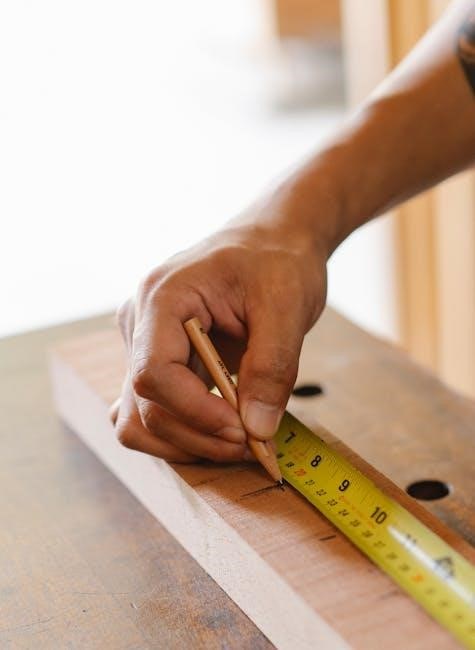Kenwood Bread Maker Instruction Manual: A Comprehensive Guide
Unlock the full potential of your Kenwood bread maker! This comprehensive guide provides detailed instructions and helpful tips. Master bread baking with ease.
Understanding Your Kenwood Bread Maker Model
Before embarking on your bread-making journey‚ familiarize yourself with your specific Kenwood bread maker model. Each model‚ such as the BM250‚ BM256‚ BM350‚ and BM450‚ possesses unique features and operational nuances. Consulting your model’s dedicated instruction manual is crucial for optimal performance; Locate the model number‚ typically found on the appliance’s base or packaging.
The instruction manual contains vital information‚ including safety guidelines‚ component identification‚ control panel functions‚ and troubleshooting tips. Understanding these details will ensure safe and efficient operation. Some manuals also include recipe suggestions tailored to your model. Many manuals are available online in multiple languages‚ including English and Russian.
Explore the manual for visual aids and diagrams for easier understanding. Recognizing the specific features of your model‚ such as the rapid bake function or automatic dispenser‚ will significantly enhance your bread-making experience.

Key Features and Components
Understanding the parts is key to success. Explore the features that make Kenwood bread makers unique. From dispensers to controls‚ get to know it.
Identifying the Main Parts
Familiarize yourself with the essential components of your Kenwood bread maker. The baking pan‚ where the magic happens‚ is crucial. Ensure it’s properly seated.
The kneading blade mixes ingredients thoroughly. The control panel allows program selection. Don’t forget the viewing window for monitoring the baking process. The crust color selector lets you customize the bread.
The dispenser‚ if present‚ automatically adds ingredients. The on/off switch controls power. The program status indicator displays the current operation. Understanding these parts is key to successful bread making.
A well-maintained bread maker ensures delicious results every time. Proper assembly ensures optimal performance. Check the components before each use. Refer to the diagrams for detailed identification.
Understanding the Control Panel
The control panel is your gateway to delicious homemade bread. Explore the various buttons and settings. Each button controls a specific function‚ such as program selection.
The display screen shows the current settings and baking time. The timer allows you to delay the start of the baking process. The crust color selector lets you choose your preferred browning level.
Program selection is key to achieving the desired bread type. Familiarize yourself with each program’s unique characteristics. The start/stop button initiates or cancels the baking cycle. Understanding these controls ensures perfect results.
The control panel offers flexibility and customization; Experiment with different settings to find your perfect loaf. Always refer to the manual for detailed explanations. Proper use ensures consistent and delicious bread every time.

Initial Setup and Preparation
Before baking‚ unpack and clean your bread maker. Accurate ingredient measurement ensures success. Follow the guidelines for optimal results and delicious bread.
Unpacking and Cleaning
Upon receiving your Kenwood bread maker‚ carefully unpack all components. Remove all packaging materials‚ including any plastic films or cardboard inserts that may be present. Retain the packaging for future storage or transportation‚ if needed.
Before the first use‚ thoroughly clean the bread pan‚ kneading blade‚ and any other removable parts with warm‚ soapy water. Rinse them thoroughly and dry them completely. Do not immerse the main unit of the bread maker in water or any other liquid.
Wipe the exterior of the bread maker with a damp cloth. Ensure that all parts are completely dry before assembling the bread maker for use. These initial steps ensure hygiene and optimal performance.
Regular cleaning after each use is crucial to prevent buildup and maintain the bread maker’s efficiency. Always unplug the appliance before cleaning.
Ingredient Measurement Guidelines
Accurate ingredient measurement is essential for successful bread making. Use measuring cups and spoons specifically designed for baking. Level off dry ingredients with a straight-edged spatula for precise measurements.
When measuring liquids‚ use a liquid measuring cup and ensure it’s placed on a flat surface to obtain an accurate reading. For yeast‚ follow the recipe instructions carefully. Too much or too little yeast can significantly affect the bread’s rise and texture.
Use fresh‚ high-quality ingredients for optimal results. Store ingredients properly to maintain their freshness and potency. Water temperature is also crucial; recipes often specify warm water to activate the yeast.
Always add ingredients in the order specified in the recipe. This ensures proper mixing and gluten development. Precise measurements and careful attention to detail are key to achieving perfect loaves of bread.
Basic Bread Making Instructions
Follow these simple steps to create delicious‚ homemade bread. From ingredient preparation to baking completion‚ this section will guide you through the entire bread-making process.
Step-by-Step Guide to Making a Basic Loaf
Creating a perfect basic loaf in your Kenwood bread maker is easier than you think! First‚ ensure your bread pan is clean and dry. Then‚ carefully measure your ingredients. Typically‚ you’ll need water‚ flour‚ yeast‚ salt‚ and sugar. Add the ingredients to the bread pan in the order recommended by your Kenwood model’s manual; usually liquids first‚ followed by dry ingredients‚ with yeast last.
Next‚ securely place the bread pan into the bread maker. Select the “Basic” program setting on your control panel. Choose your desired crust color‚ if applicable‚ and press start. The bread maker will handle the kneading‚ rising‚ and baking automatically. Once the baking cycle is complete‚ carefully remove the bread pan using oven mitts. Let the loaf cool slightly before slicing and enjoying your freshly baked bread.
Program Selection and Customization
Your Kenwood bread maker offers a variety of programs beyond the basic loaf. Explore the menu to find settings for whole wheat‚ French bread‚ sweet dough‚ and even gluten-free options; Each program is pre-set with specific kneading‚ rising‚ and baking times to optimize results for different dough types.
Customization is key to achieving your desired outcome. Many Kenwood models allow you to adjust the crust color from light to dark. Some also offer a delay timer‚ enabling you to set the bread maker to start baking later‚ ensuring a warm loaf in the morning. Experiment with different settings to discover your preferences. For example‚ try adding nuts‚ seeds‚ or herbs to the dough for a unique flavor profile. Always consult your manual for program details!

Troubleshooting Common Issues
Encountering problems with your Kenwood bread maker? This section provides solutions for common issues. Learn to diagnose and resolve problems‚ ensuring perfect bread every time.
Addressing Common Problems
Is your Kenwood bread maker acting up? Don’t worry‚ many issues are easily resolved. One common problem is the bread not rising properly. This could be due to expired yeast‚ incorrect ingredient measurements‚ or a faulty heating element. Check the expiration date of your yeast and ensure you’re using accurate measuring tools.
Another frequent issue is a loaf that’s too dense. This is often caused by using too much flour or not enough water. Refer to the recipe and double-check your ingredient ratios. If the bread is burning on the outside but still doughy inside‚ try reducing the crust color setting or using a lighter bread flour.
Sometimes‚ the paddle may get stuck in the loaf. To prevent this‚ grease the paddle lightly before adding ingredients. If it’s already stuck‚ let the bread cool completely before attempting to remove it. For persistent problems‚ consult the troubleshooting guide in your Kenwood bread maker manual for specific error codes and solutions.
Understanding Error Codes
Kenwood bread makers‚ like other appliances‚ sometimes display error codes to indicate specific problems. These codes are crucial for diagnosing and resolving issues quickly. An “E01” error‚ for example‚ might signal a temperature sensor malfunction‚ requiring you to contact Kenwood support. “E02” could indicate an overheating problem‚ suggesting you let the bread maker cool down before restarting.
Consult your Kenwood bread maker manual for a comprehensive list of error codes and their meanings. Each model may have unique codes‚ so referencing the correct manual is essential. Understanding the error code helps you determine if the problem is something you can fix yourself‚ such as a power surge‚ or if it requires professional assistance.
Ignoring error codes can lead to further damage to your bread maker. Always address them promptly and accurately. If the manual doesn’t provide sufficient information‚ contact Kenwood’s customer support for guidance.

Care and Maintenance
Proper care ensures longevity. Regular cleaning and correct storage are vital. This section details how to maintain your Kenwood bread maker‚ keeping it in prime condition for years.
Cleaning and Storage
Maintaining your Kenwood bread maker involves regular cleaning and proper storage. After each use‚ unplug the bread maker and allow it to cool completely. Remove the baking pan and kneading blade. Wash them with warm‚ soapy water. Ensure all parts are completely dry before reassembling.
The baking pan can be washed in the dishwasher‚ but hand washing is recommended to prolong its lifespan. Wipe the interior and exterior of the bread maker with a damp cloth. Avoid using abrasive cleaners or scouring pads‚ as they can damage the surface.
Never immerse the bread maker in water or any other liquid. Store the bread maker in a cool‚ dry place‚ away from direct sunlight and heat. Ensure all parts are securely stored to prevent damage. A clean and well-stored bread maker ensures optimal performance for future use.
Extending the Lifespan of Your Bread Maker
To prolong the lifespan of your Kenwood bread maker‚ consistent care is essential. Always follow the cleaning and storage instructions provided. Use the recommended amount of ingredients to prevent overworking the motor. Avoid using excessive force when inserting or removing the baking pan.
Regularly check the kneading blade for wear and tear and replace it if necessary. Protect the bread maker from power surges by using a surge protector. Allow the appliance to cool down completely between uses.
Descaling the baking pan periodically can prevent mineral buildup. Do not overload the bread maker with ingredients beyond its capacity. Avoid using damaged or incompatible parts. Store the bread maker in a dry environment to prevent corrosion. Following these simple tips will ensure your bread maker remains in excellent working condition for years.







Leave a Reply
You must be logged in to post a comment.